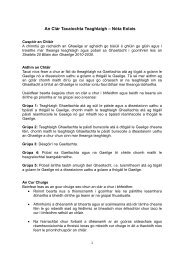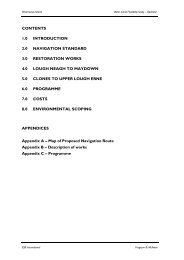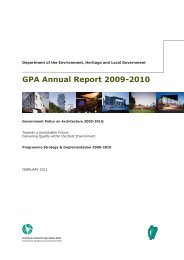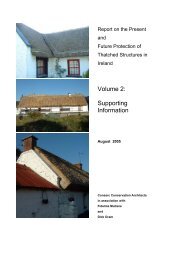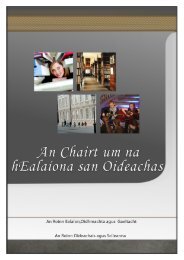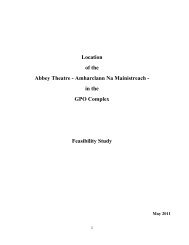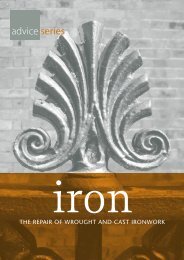A Guide to the Repair of Historic Roofs - Dublin City Council
A Guide to the Repair of Historic Roofs - Dublin City Council
A Guide to the Repair of Historic Roofs - Dublin City Council
You also want an ePaper? Increase the reach of your titles
YUMPU automatically turns print PDFs into web optimized ePapers that Google loves.
ROOFS A GUIDE TO THE REPAIR OF HISTORIC ROOFSGLAZINGPatent glazing set in<strong>to</strong> <strong>the</strong> pitch <strong>of</strong> <strong>the</strong> ro<strong>of</strong> was <strong>of</strong>tenused <strong>to</strong> light <strong>the</strong> interiors <strong>of</strong> industrial structures, but isfound on many types <strong>of</strong> building. It is formed by anarmature <strong>of</strong> timber or metal set on<strong>to</strong> <strong>the</strong> ro<strong>of</strong>structure on one or both sides <strong>of</strong> <strong>the</strong> ridge. Glazingbars extend <strong>the</strong> full length <strong>of</strong> each side, glazed inpanes fixed by gaskets. The glazing is wea<strong>the</strong>red <strong>to</strong> <strong>the</strong>upper and lower edges <strong>of</strong> <strong>the</strong> framework with lead orzinc flashings. Similar construction methods are usedfor projecting ro<strong>of</strong> lanterns.Fully glazed ro<strong>of</strong>s, such as conserva<strong>to</strong>ry ro<strong>of</strong>s, wereusually constructed using timber or iron armatures,with glazing bars extending <strong>the</strong> full length <strong>of</strong> eachpitch. The glass sat directly on<strong>to</strong> <strong>the</strong> framework inpanes <strong>of</strong> less than a metre long. Each was curved <strong>to</strong><strong>the</strong> lower edge <strong>to</strong> throw <strong>of</strong>f water, and <strong>to</strong> lap over <strong>the</strong>pane below. The panes were puttied at <strong>the</strong> sides only.TARRED CLOTH, ASPHALT, CONCRETE ANDASBESTOSTarred cloth was used in <strong>the</strong> 1850s for cladding <strong>the</strong>lightweight curved pine ‘Belfast’ trusses constructedon <strong>the</strong> workers’ houses introduced by <strong>the</strong> Malcolmsonfamily in Portlaw.Hot rolled asphalt was available from <strong>the</strong> 1890s and,although used infrequently at that time, it becamemuch more prevalent in <strong>the</strong> twentieth century, whenflat ro<strong>of</strong>s came in<strong>to</strong> fashion. Asphalt shingles were alsoavailable from <strong>the</strong> late-nineteenth century andbecame prevalent from <strong>the</strong> early <strong>to</strong> mid-twentiethcentury as an economical substitute for natural slateand tiles.Glass ro<strong>of</strong>s, using timber or iron structural elements,were used on conserva<strong>to</strong>ries and greenhouses andcan be extensiveSHEET MATERIALS AND METALSO<strong>the</strong>r ro<strong>of</strong>ing materials include seamed zinc sheet,which is described as bluish-white in appearance andas a medium hard metal which is reasonably brittle,particularly at low temperatures. From <strong>the</strong> mideighteenthcentury it was used for ro<strong>of</strong>ing and in <strong>the</strong>1830s it began <strong>to</strong> be used for sculpture and decorativeelements. Today zinc is used <strong>to</strong> provide a protectivecoating on steel through processes such as galvanising,sheradising and zinc spraying, or as a fashionablero<strong>of</strong>ing material for contemporary ro<strong>of</strong> pr<strong>of</strong>iles.Asphalt shingles were introduced as early as 1890,although <strong>the</strong>ir use is more usually associated withbuildings dating from <strong>the</strong> 1930sConcrete tiles and asbes<strong>to</strong>s sheeting becameprominent in Ireland from <strong>the</strong> 1930s onwards,particularly on local authority housing schemes.40




